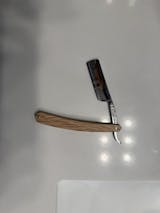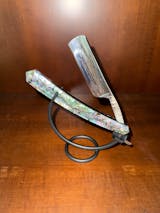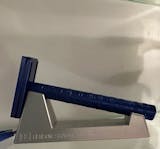When you start wet shaving it can be confusing to figure out how many razor blades to buy and what makes a sharp blade. If you’re making the switch from cartridges or electronic trimmers - or are just new to shaving with a double edge safety razor - then knowing just how long safety razor blades last, and how often to switch out your double edge razor blades saves time and money.
This article will help you figure out how often you should change your “razor blades”, how long a safety razor blade lasts, how to extend the life of your DE safety razor blades, and how to keep them sharp - for a close, smooth and superior shave.
To get started, let’s take a look at two critical factors that impact DE blade changing frequency:
- Facial hair thickness & coarseness
- Wet shaving routine

What Kind of 5 O'clock Shadow Do You Have?
Coarseness is a measure of hair thickness, and men generally have three different kinds growing out of their faces:
- Soft hair (fine hair)
- Medium hair (normal hair)
- Coarse hair (thick hair)
The thicker the follicle, the coarser the hair. The thinner the strand the softer the hair.
It can be difficult to measure on your own. But, rub your hand over your stubble–If it’s painful and your significant other avoids kissing you,you’re coarse, if it feels like lower grit sandpaper, you’re medium, if it feels a little like head hair then it’s soft.
Guys with soft to medium facial hair will get more hacks per blade than their more wooly brethren.
How Long Does A Safety Razor Blade Last?

The general rule you are wet shaving daily you will need to replace your blades after five to six shaves or once a week. It really depends on the several factors such as facial hair thickness, the type of blade, how you care for your safety razor blade, and your technique .
Here's why:
Reusable safety razor blades lose their sharpness after an extended period of usage and immediately after the first wet shave. That essentially leads to a dull blade that doesn’t shave as well as it should. When it’s not sharp enough, the chances are that you’ll end up with and cuts, razor bumps, razor burn because of rough shaving patterns from applying too much pressure when using the razor. You can, however, keep your edge longer by sharpening your safety razor blade, however sharpening a razor blade isn't foolproof and blades are cheap.
Aside from nicks and cuts, a dull blade can also lead to a few ingrown hair-related problems as it will have a tendency to tug slightly before shaving the hair off,causing persistent irritation on the skin.The factors that determine how long your DE safety razor blade will last in your traditional razor and how long before you lose shaveability are based hair thickness, how often you shave, experience with wet shaving, the type of double edge safety razor blade you prefer, the type of material of the blade, and coating if any.
But as a general rule, it really comes down to personal preference. Razor blades are cheap ranging from 10 cents a blade and up so there is no excuse to sacrifice a close and comfortable shave with a dull blade or a blade that isn't right for you.
With experience you will intuitively feel when a blade loses its edge.Because DE blades are far cheaper than cartridge systems in time you will find the perfect blade that matches your facial hair type. If this seems a bit daunting lets break it down as a general rule.
Most safety razor blades will dull with every shave. Expect any blade to last five shaves and up with proper technique and maintenance. Some blades such as carbon steel with Teflon and platinum coating will last up to two weeks so with time and experimentation with sampler packs you will find your perfect match.
How Long do Safety Razor Blades Last Based On Facial Hair Type?
Coarse Hair
- More than three shaves per week: 8 blades (about 2 per week)
- Three or fewer shaves per week: 4 blades (About once per week)
- More than three shaves per week: 8 blades (about 2x per week)
- Three or fewer shaves per week: 4 blades (about once per week)
- More than three shaves per week: 4 blades (about once per week)
- Three or fewer shaves per week: 2 blades (about once every two weeks)
Pro Tip: If you shave daily you should change your razor blades around once or twice a week, and if you shave less frequently, once a week will probably do.
Never Experience A Dull Blade Ever Again
Shaving with a sharp double edge safety razor blade every time means you never have to feel the sting of a serrated edge sweep across your face.
Here are a few more reasons:
- Dull double edge blades give you a less effective shave
- Old blades can cause more nicks and cuts
- Less sharp razors cause you to shave with too much pressure and cause the blade to dull faster
- Blunted blades can lead to skin irritation and rashes especially on sensitive skin
- Shaving sensitive areas such as head shaving
Get the Most Out of Every Safety Razor Blade...& A Better Shave Routine

Buying razor blades online is easy and cheap, and when you find the right wet shaving product store you will always know where to buy razor blades that are tested and right or your skin and facial hair type. Understand cheap blades never last and even the sharpest razor blades don’t last forever. A razor blade is meant to be thrown away or recycled, they are just metal after all.
Guys love them because they are super cheap! Who doesn’t like saving money? My favorite is buying them in a bulk pack such as the Feather hi stainless steel costing between 39 and 60 cents each. But, let’s be honest: You could probably start with a new razor blade each and every time and still spend less money compared to a cartridge razor, which costs on average $3 for one blade!
But you didn’t get this far in life by tossing away a perfectly good razor (or get as good a shave by using a cartridge razor). Exactly what you want is to get the most shaves possible with the same blade while also never experiencing the nasty sting of a dull edge.
Below are the factors you need to pay attention to to become a future-predicting shaving sorcerer.
7 Factors That Determine How Long Your Safety Razor Blade Will Last

Use this guide to learn how to estimate the number of shaves you can get out of one safety razor blade before any unpleasant feelings send you t looking for a replacement.
1. Hair Type
There are several ways to look at double edge razor blade longevity when it comes to facial hair type:
The coarseness of your facial hair directly relates to blade life. Guys with thinner, softer follicles will get more passes out of a razor blade than those with a thick, coarse forest growing out of their face. Thick facial hair wears down the blade's edges quicker.
The length of hair impacts how long razor blades last. Shaving a 5 o'clock shadow vs. moderate stubble vs. an actual beard puts different wear and tear on razor blades. Longer hair tends to clog up a blade, so it requires more swipes which wears the razor blade down (Use an open comb blade if you need to hack more aggressively). Shorter hairs can be cleaved with less effort, causing less trauma to the blade’s edges.
The density and thickness of facial hair affect the longevity of the blade. The denser the shaving area, the more follicles the blade will cut, which will require you to change the blade more often.
2. Shaving Surface Area
The larger the surface you shave, the more the blade dulls and the more frequently you will change your safety razor blades. But there are a few different areas with different types of hair growth every shaver should consider:
- Cheeks
- Chin
- Mustache
- Neck
- Sideburns
- Scalp
- Soul patch (beneath bottom lip)
If you check only a box or two, you’ll change blades at a lower speed than someone shaving all seven areas.
However, some of these shaving areas cause more damage to razor blades than others. For example, the hair on your chin and mustache tends to be coarser than your sideburns or head (or legs for the cyclists and swimmers out there) causing more damage to the blade per stroke. The hair on your neck can grow in more directions than on your cheek, needing more sharpness-reducing passes of your double edge blade.
Bottom line: It’s about how the square inches you want to shave and the hair type in the specific surface area.
Here's a guide to mapping the face to help you out.
3. Frequency of Shave
If you shave daily you will have to change their razor blades with greater frequency than guys who only need to shave every few days. This only makes sense. Shaving more frequently leads to a dull blade.
4. Safety Razor Blade Quality
The quality of the blade also is an important part of making the sharp edge of a safety razor last longer. Here’s what you should look for in razors:
- Material: Stainless steel safety razors stay sharper longer than other materials, like carbon steel metal, which can start rusting in moist environments like your bathroom. Luckily, blades from the best brands are made from stainless steel.
- Coating: A coating, like platinum, chromium, ceramic, and tungsten (or all combined) is a factor that makes blades last longer. They decrease friction and offer a smoother shave.
- Grinding: Grinding refers to the out-of-the-package sharpness and thickness of the blade. Find a blade that gives your shave the best performance. Some men prefer a duller blade to start, others need one that is extra sharp.
- Brands: Use high-quality razor blades from reputable brands to give you more shaves per blade and make the act of shaving feel a lot smoother. Low-quality blades need to be swapped out more often.
There’s a saying with safety razors: Your mileage may vary. Every blade performs differently depending on the safety razor you are using as well as your skin and hair type. Try a variety before settling on one.
5. Shaving Technique and Beard Prep
Your shaving routine also has an impact on safety razor blade longevity.
Use a pre-shave oil or cream, and make a lather with shaving soap to add moisture to the skin and soften the facial hair. This makes your beard less labor-intensive for the blade to slice through.
The rate of strokes per shave also matters. Some guys are lucky. They can gently swipe down on the first pass and get a close shave. But other men will need to use the three-pass technique to get the same result (direction of the grain, horizontal to the grain, and then against the grain).
Even though fewer strokes make razor blades last, always go for the technique that lands you a shave smooth enough to kiss.
6. How To Store Safety Razor Blades
How safety razors blades are stored impacts their lifespan and sharpness. Poor storage habits make blades corrode more quickly.
So, rinse and dry them thoroughly with a towel–the combination of water and salt eats away at stainless steel. Then, clean them with alcohol and dab the razor blade with oil. Skip the shower and keep it in a dry environment, away from water and humidity such as a bathroom drawer or cabinet.
7. Strop Use
Stropping is a method of polishing It can be thought of as a blade sharpener that makes safety razor blades last longer (as well as straight razors). If you use a strop, you’ll have to change your blade fewer times than if you don’t.
To help you remember how many times you’ve used a blade, keep a piece of dice nearby and rotate it from 1 to 2, etc. each time you shave.

Here are some of the most frequently asked questions about safety razor blades
Is there any one sign that it’s time to replace the blade?
The major telltale sign? Pain and continuously reaching for an Alum block.
Shaving with an expired blade or reusable razor may feel dull and causes nicks, cuts, and irritation. However, poor shaving techniques also cause the same problems.
My personal rule of thumb is to make sure you’re shaving with the razor properly. Use a low amount of pressure and angle the blade away from your mug. Too much pressure causes razor blades to dull faster. If the blade still behaves like a hacksaw when applying pressure or if you feel a tug slightly, then reach for a replacement. The more pressure you apply when holding the razor will cause the blade to dull faster so go easy this and be gentle.
How do you sharpen razor blades
A safety razor blade cant technically be sharpened rather honed or polished. Safety razors regain sharpness when they get polished -- or in shaving terms, “stropped.” Most find the process of stropping razor blades works for them but it’s a good idea to start with a few general tips in our guide.
The act of sharpening a safety razor blade can make it last for many more shaves than it might have otherwise.
What should beginners expect?
If you’ve recently ditched cartridge multi-blade razors it can take some time to get used to shaving with sharper blades, and ditch those cartridge razors for good. At first, you’ll probably need replacement blades at a higher rate than you did with your cartridge razor, but once you find the perfect slant and pressure to shave with, it will likely go down.
How often do you change your razor head?
This is the part of the razor handle that holds the double edge blades. They come with different guards that change the intensity of the shave, and they only get changed when desired.
What do you do with a used blade?
You’re right to think you shouldn’t just toss a sharp object in the trash. Not only would it be more than happy to slice through your bag, but they can be recycled. Most recycling centers have drop boxes and some municipalities offer collections programs. A safe storage container like a blade bank offers a safe place to store them in the meantime. Or just slide the blade carefully in the bottom of your razor blade pack.
How do you put a blade in a safety razor?
There are different types of safety razor designs–One, two and three pieces. One piece or butterfly razor heads are the easiest to swap a blade out, with a simple twist of the handle the head opens like a butterfly and the blade pops out, with two and three piece design it involves disassembling the handle and head and base plate and realigning the blade on the base place. Most manufacturers will include instructions on how to swap out blades on traditional razors and YouTube will also be a great resource for learning how to align blades after changing them.

The Wrap Up...
Knowing when to change your razor blade results in a smooth shave every time and allows the blade to effortlessly mow a field of stubble off your face. It is an incredible sensation!
Be the shaving pro you were meant to be -- focus on the seven factors above. This way, you can anticipate when your blade is ready to be discarded before any unfortunate stroke slices the joy out of your shave.
For more info visit our Shaving FAQ and Tips page.















